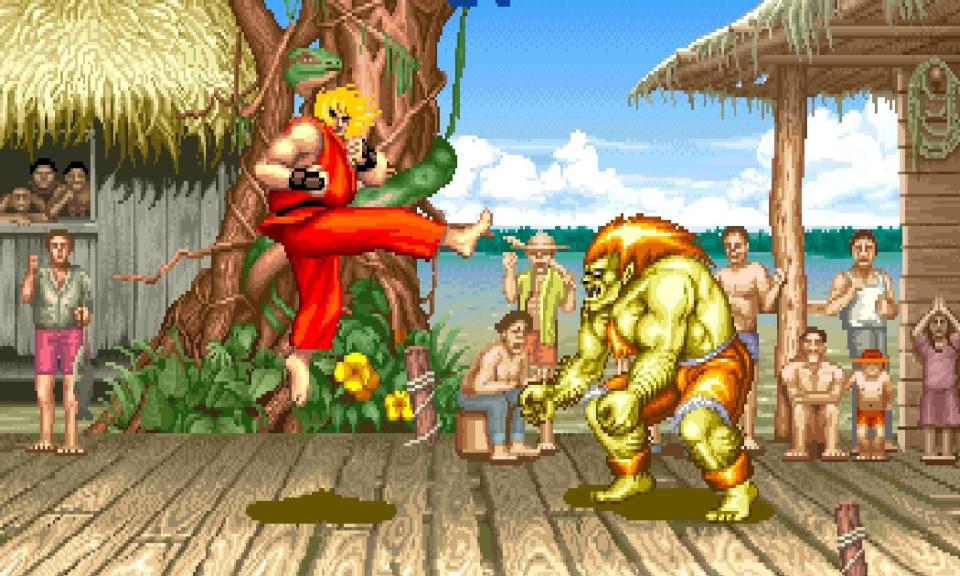Street fighting years: when Tekken and its enemies ruled the world

Friday night, back from the pub with your housemates and a few hangers on. Staple 1990s yoof TV show The Word has just finished with a raucous live performance by some up-and-coming grunge band and now it’s time to play video games.
In the decade of the original PlayStation and the Sega Saturn, there was no online multiplayer – if you wanted to compete against human beings, you did it in your living room with friends, and anyone else you found in the pub at closing time. It had to be something accessible, something competitive, something that allowed two or even four people to play at once. It needed to have short rounds, because everyone wanted to play. Invariably that would mean one of two options: a footie sim or a fighting game.
In the mid-1990s, fighting games were, alongside driving sims, the hottest genre on consoles. At the time, big hardware manufacturers and arcade companies were keen to dominate the emerging market for real-time 3D games – games with polygonal characters and environments, replacing the essentially flat 2D worlds of sprites and backdrops. These games were the future – and the fighting genre was the perfect showcase: they featured big character models, which benefited from 3D graphics and slick animation, but they also had largely static arenas, so you didn’t have to fill the disc or system memory with a lot of environmental data. They also had a huge fanbase thanks to 1980s classics such as Yie Ar Kung-Fu and Karate Champ, as well as the early 1990s hits Street Fighter 2 and Mortal Kombat. It was the perfect fit.
So in 1995, you had Tekken on the PlayStation v Virtua Fighter on the Saturn. There was also the beautiful Battle Arena Toshinden by Tamsoft, sporting at the time cutting edge texture-mapped visuals, weird characters and a feast of special moves. When Tekken 2 arrived in August 1995, it sold over 5m copies, cementing the importance of the genre with its cinematic sequences and cool combatants. A year later, the N64 entered the fray with Killer Instinct Gold, Sega gave us Fighting Vipers and Last Bronx, and Capcom was busy frantically diversifying the genre with Street Fighter Alpha 2, the horror themed Darkstalkers: The Night Warriors, the 3D weapons based sci-fi battler Star Gladiator, and the crossover classic, X-Men vs Street Fighter. Even Final Fantasy creator Squaresoft tried its hand with the strange futuristic fighter Tobal No 1, which became a bestseller in Japan although arguably because it came with a playable demo disc for Final Fantasy VII.
Fuelled by success in the arcade and the home console markets, the fighting game genre became a place to experiment. 1997 saw the hugely acclaimed and still eminently playable Bushido Blade, an authentic samurai sim in which one strike could kill your fighter in a splash of pixelated blood. In my house, we loved Bloody Roar, the lycanthropic brawler from Hudson in which characters could transform into ravenous beasts. Capcom’s Rival Schools: United by Fate was an interesting school-based one-on-one fighter with a wider narrative, referred to by an IGN reviewer as the “Beverly Hills 90210 of the fighting arena”. It also inspired both the name of the American emo band, Rival Schools, and their debut album, United By Fate, underlining the connection between gaming and music for a new generation of fans.
It seemed each week there was some new twist on the genre. The Marvel vs Capcom and Kizuna Encounter games brought in tag-team fighting, a concept that the whole subgenre of wrestling sims really ran with throughout the late 1990s and early 2000s. We had hybrids that combined the brawler and fighting game genres, such as Capcom’s wonderful Power Stone and Sega’s overlooked Spike-Out (which admittedly didn’t get a console release until 2005). At the same time the lads mag mentality of the era fed into the games or at least their marketing, with titles such as Dead or Alive being marketed as much on the look of their female characters as on the gameplay mechanics.
Related: Kapow! The history of fighting games
Fighting games never went away. Even as people began to drift online for first-person shooters such as Call of Duty, or abandoned social play altogether for the new narrative adventure titles – the Tomb Raiders, resident Evils and Grand Theft Autos – Tekken, Street Fighter, Soulcalibur, Guilty Gear and a few other stalwarts clung on, supported by an intensely competitive community. It is lovely now to see the renewed interest through the masterful Street Fighter 6, the ridiculous Mortal Kombat 1 and the recent Tekken 8. I hope it ignites a passion for the older titles, the ones we played from 11.30pm to 5am on Friday evenings once The Word was over. Honestly, the Street Fighter games are all worth playing; Tekken 3 remains a benchmark classic; Virtua Fighter 4 Evolution is beautiful and complex. You can then work your way into the cult SNK greats – Art of Fighting, Fatal Fury et al – or dive down an Arc System Works rabbit hole into the frankly insane Guilty Gear universe.
The colours, the sounds, the characters, the combat … the kudos you got from successfully pulling off a super special move, hurling your mate’s character into outer space. The camaraderie of the arena. Logging on to the internet to raid the GameFaqs site for fan-produced lists of character moves and combos. Investing in your first Hori fighting stick, while giving your friends your crappy third-party controllers to play with. The 1990s was the decade games grew up, diversified, brought in new people, put tentacles out to wider culture – it was the furnace of the modern industry. And there at the absolute forefront, for a few wild, bright years, was the fighting game.

 Yahoo Finance
Yahoo Finance 